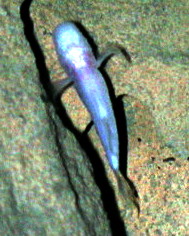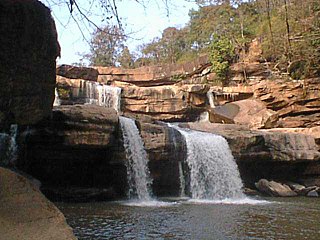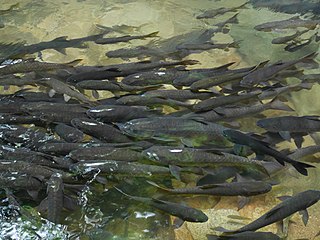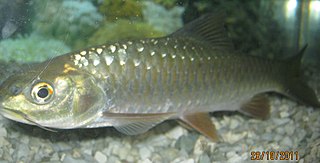
Mahseer is the common name used for the genera Tor, Neolissochilus, Naziritor and Parator in the family Cyprinidae (carps). The name is, however, more often restricted to members of the genus Tor. The range of these fish is from Vietnam in the east and China in the north, through Laos, Cambodia, Thailand, Malaysia, Brunei and Indonesia, and across southern Asia including the countries of India, Nepal, Bhutan and Bangladesh within the Indian Peninsula, plus Sri Lanka, Pakistan and Afghanistan. They are commercially important game fish, as well as highly esteemed food fish. Mahseer fetch high market price, and are potential candidate species for aquaculture. Several of the larger species have suffered severe declines, and are now considered threatened due to pollution, habitat loss, overfishing and increasing concern about the impacts of unregulated release of artificially bred stock of a very limited number of species.

The Alabama cave shrimp is a species of shrimp in the family Atyidae, found only in caves in the state of Alabama.
Neolissochilus thienemanni, the ihan, is a species of ray-finned fish in the family Cyprinidae. It is found only in Lake Toba on the island of Sumatra, Indonesia.

Neolissochilus is a genus of fish in the family Cyprinidae native to freshwater habitats in Asia that are often grouped with the mahseers. The largest reach up to 1.2 m (3.9 ft) in length, but most species are much smaller.
The West Virginia spring salamander is a species of troglobitic salamander in the family Plethodontidae. It is endemic to West Virginia, the United States.

Typhlichthys subterraneus, the southern cavefish, is a species of cavefish in the family Amblyopsidae endemic to karst regions of the eastern United States.

Thung Salaeng Luang National Park is a 1,262 square kilometres (487 sq mi) national park in Phitsanulok and Phetchabun Provinces of Thailand. It encompasses substantial portions of Wang Thong and Lom Sak Districts.

Cavefish or cave fish is a generic term for fresh and brackish water fish adapted to life in caves and other underground habitats. Related terms are subterranean fish, troglomorphic fish, troglobitic fish, stygobitic fish, phreatic fish, and hypogean fish.

Neolissochilus wynaadensis, the Wayanad mahseer, is a species of cyprinid fish. It is endemic to the Wyanad Plateau and its surroundings in the southern Western Ghats, India. It occurs in fast-flowing rivers and streams with rock substrates. This species can reach a length of 50 centimetres (20 in) TL. It is of minor importance to local commercial fisheries.

Khuean Srinagarindra National Park is a national park in Kanchanaburi Province, Thailand. The park, centred on the Srinagarind Reservoir, is part of the Western Forest Complex protected area.

Tham Pla–Namtok Pha Suea National Park is a national park in Mae Hong Son Province, Thailand. It is home to caves, waterfalls and steep mountain terrain. It was established as a national park on 23 December 2010.

Neolissochilus soroides, commonly called the soro brook carp is a species of freshwater ray-finned fish belonging to the family Cyprinidae, the family which includes the carps, barbs and related fishes. This species ios found in Thaikand, Malaysia and Sumatra.
Tham Phra Wang Daeng, also known as the Cave of the Monk, is a deep cave located in Thung Salaeng Luang National Park, Amphoe Noen Maprang, Phitsanulok Province, upper central Thailand. It is the longest cave in Thailand, the distance is about 13 kilometers. Buddhist statues and relics, carvings and reliefs, a subterranean river, multiple bat colonies, and a trove of speleothems populate the cave. In 2003, a biological expedition to the cave resulted in the discovery of new fish species, including discoveries in the Balitoridae and Cyprinidae families.
Neolissochilus blanci is a species of freshwater ray-finned fish belonging to the family Cyprinidae, the family which includes the carps, barbs and related fishes. This species is found in the Mekong, Chao Phraya and Mae Klong rivers in Thialnd, Laos, Cambodia and Viet Nam. It may also be found in Myanmar and southern China.

Neolissochilus hexagonolepis, the copper mahseer, chocolate mahseer or katli, is a species of freshwater ray-finned fish belonging to the family Cyprinidae, the family which includes the carps, barbs and related fishes. This species is found in Nepal, eastern India, Bangladesh, Myanmar, Thailand, Malaysia and Sumatra. It may also be present in China and Viet Nam, also the record sof this species from the easyetn part of its range is uncertain and reports may be misidentifications.
Neolissochilus nigrovittatus is a species of cyprinid in the genus Neolissochilus. It inhabits Myanmar and Thailand and has a maximum length of 13.0 centimetres (5.1 in).

Cho Hae is a tambon (sub-district) of Mueang Phrae District, Phrae Province, northern Thailand.

Wat Tham Chiang Dao (วัดถ้ำเชียงดาว) is a limestone cave temple located in the foothills of the Doi Luang Chiang Dao, the third-highest mountain in Thailand, north of Chiang Mai. The exact origins of the temple are unknown, but it is believed to have been established during the Lanna Kingdom period. The temple is known for its peaceful atmosphere and scenic surroundings. The temple’s caves are central to its meditation practices, attracting both pilgrims and tourists.













